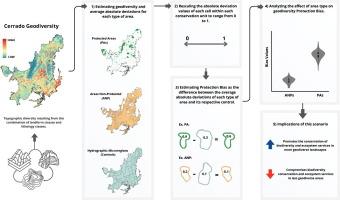Geodiversity conservation in the Cerrado: Representation of geophysical scenarios in the biome's protected areas network
IF 4.4
1区 环境科学与生态学
Q1 BIODIVERSITY CONSERVATION
引用次数: 0
Abstract
Geodiversity is the abiotic variation in Earth's surface and subsoil, the basis for the existence and diversification of biodiversity and environmental and ecosystem services. Furthermore, it is considered important in the context of climate adaptation strategies, with the promotion of microclimatic refugia for species. Currently, geodiversity conservation should be favored initially in regions that are naturally more geodiverse, as these regions tend to be less suitable for other human activities, mainly in historically neglected biomes, such as the Cerrado. Based on this premise, we evaluate the protection of geodiversity in the Cerrado biome by measuring the variation in geodiversity inside and outside protected and non-protected areas. To achieve this, we considered the difference between the average variation in geodiversity of each area (protected and non-protected areas) and the average value of its respective hydrographic microregion. We identify that a priori, the conservation of the Cerrado biome is an important component to achieving the objectives of the conservation strategy of a great and diverse geophysical scenario. Approximately 67 % of the variation in conservation bias in the Cerrado was explained by the distribution of geodiverse areas in this biome. Areas under protection were generally allocated in regions of higher geodiversity than non-protected areas. However, the efficiency of this strategy depends on aspects related to the governance of these areas. Furthermore, this bias neglects ecosystems' differences, which can compromise biodiversity conservation and ecosystem services in less geodiverse areas.

塞拉多地区的地质多样性保护:生物群落保护区网络中地球物理情景的表现
地质多样性是地表和底土的非生物变化,是生物多样性、环境和生态系统服务存在和多样化的基础。此外,它在气候适应策略的背景下被认为是重要的,促进了物种的小气候避难。目前,地质多样性保护应首先在自然地质多样性较高的地区进行,因为这些地区往往不太适合其他人类活动,主要是在历史上被忽视的生物群系,如塞拉多。在此前提下,我们通过测量保护区和非保护区内外地质多样性的变化来评价塞拉多生物群系的地质多样性保护情况。为了实现这一目标,我们考虑了每个地区(受保护和非保护区)地质多样性的平均变化与其各自水文微区平均值之间的差异。我们认为,塞拉多生物群落的保护是实现一个伟大的和多样化的地球物理情景的保护战略目标的重要组成部分。塞拉多地区约67%的保护偏倚差异可归因于该生物群系中地质多样性区域的分布。受保护地区一般分布在地质多样性高于非保护区的地区。然而,这一战略的效率取决于与这些领域的治理有关的方面。此外,这种偏见忽视了生态系统的差异,这可能会损害生物多样性保护和生态系统服务在地理多样性较少的地区。
本文章由计算机程序翻译,如有差异,请以英文原文为准。
求助全文
约1分钟内获得全文
求助全文
来源期刊

Biological Conservation
环境科学-环境科学
CiteScore
10.20
自引率
3.40%
发文量
295
审稿时长
61 days
期刊介绍:
Biological Conservation is an international leading journal in the discipline of conservation biology. The journal publishes articles spanning a diverse range of fields that contribute to the biological, sociological, and economic dimensions of conservation and natural resource management. The primary aim of Biological Conservation is the publication of high-quality papers that advance the science and practice of conservation, or which demonstrate the application of conservation principles for natural resource management and policy. Therefore it will be of interest to a broad international readership.
 求助内容:
求助内容: 应助结果提醒方式:
应助结果提醒方式:


